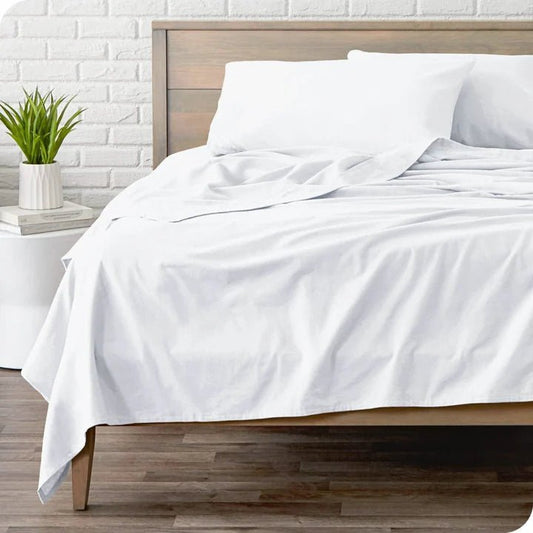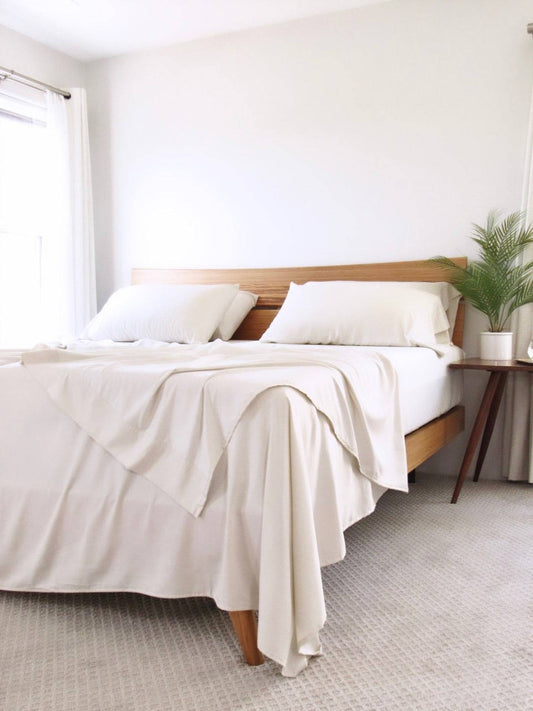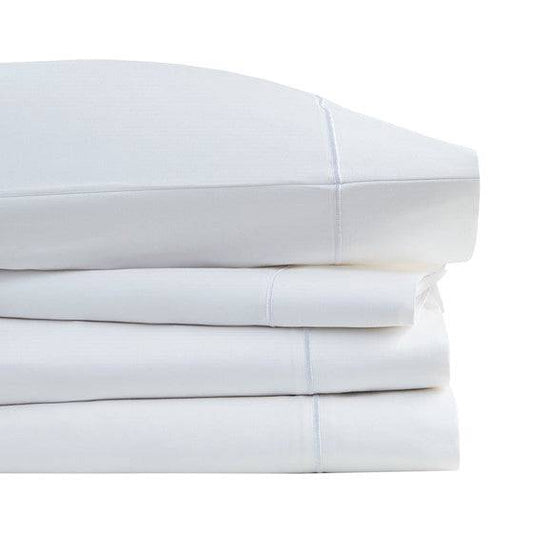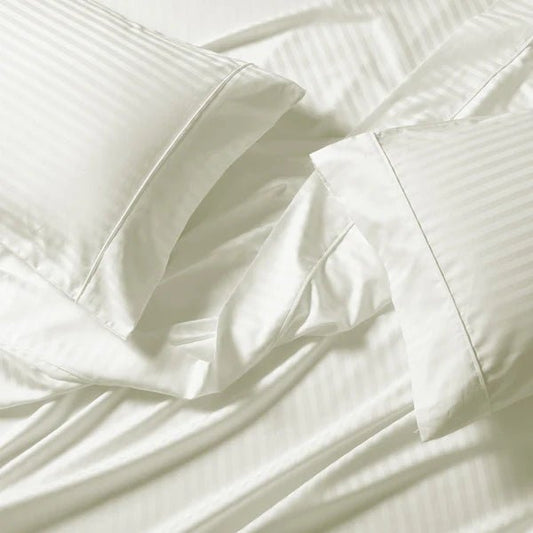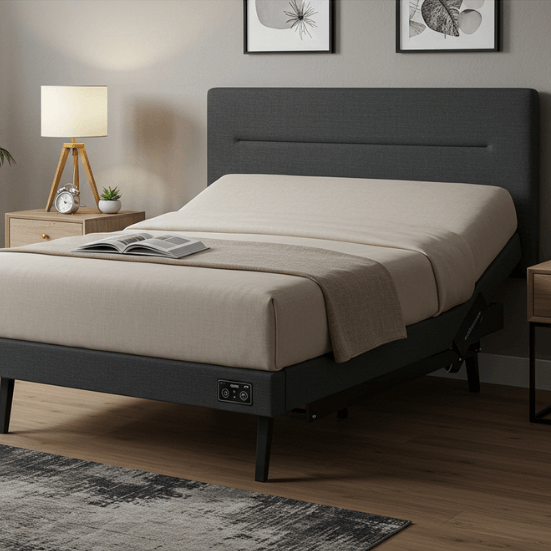
What Are the Health Benefits of an Adjustable Bed?
One of the effective ways to improve sleep quality is switching to an adjustable bed. Many people struggle with poor sleep and body discomfort. In most cases, a flat mattress doesn’t offer the right support. This can lead to restlessness and neck and back pain. Having an adjustable bed is really helpful for this. Its ability to raise your head or legs can improve comfort and posture. And more importantly, it can support your overall health. In this blog, we’ll talk about the key benefits of an adjustable bed. From easing back pain to improving blood circulation, this simple upgrade is what you need. So, let’s discuss it in detail.
Are Adjustable Beds Good for Health?
Adjustable beds are beneficial for your health in a lot of ways. They help improve circulation and relieve body pains. They ease conditions like acid reflux and sleep apnea. An adjustable bed allows you to elevate the head or legs, which enhances comfort and sleep quality. However, know that you can’t replace it with professional treatment. Individual needs vary, and consulting a healthcare provider is always a wise decision.
Top 15 Health Benefits of an Adjustable Bed
An adjustable bed does more than add luxury to your bedroom. It can be really good for your health and well-being. From easing back pain to improving blood flow, these beds offer the support your body needs. Here are the top 15 benefits of an adjustable bed that show how it can positively impact your daily life.
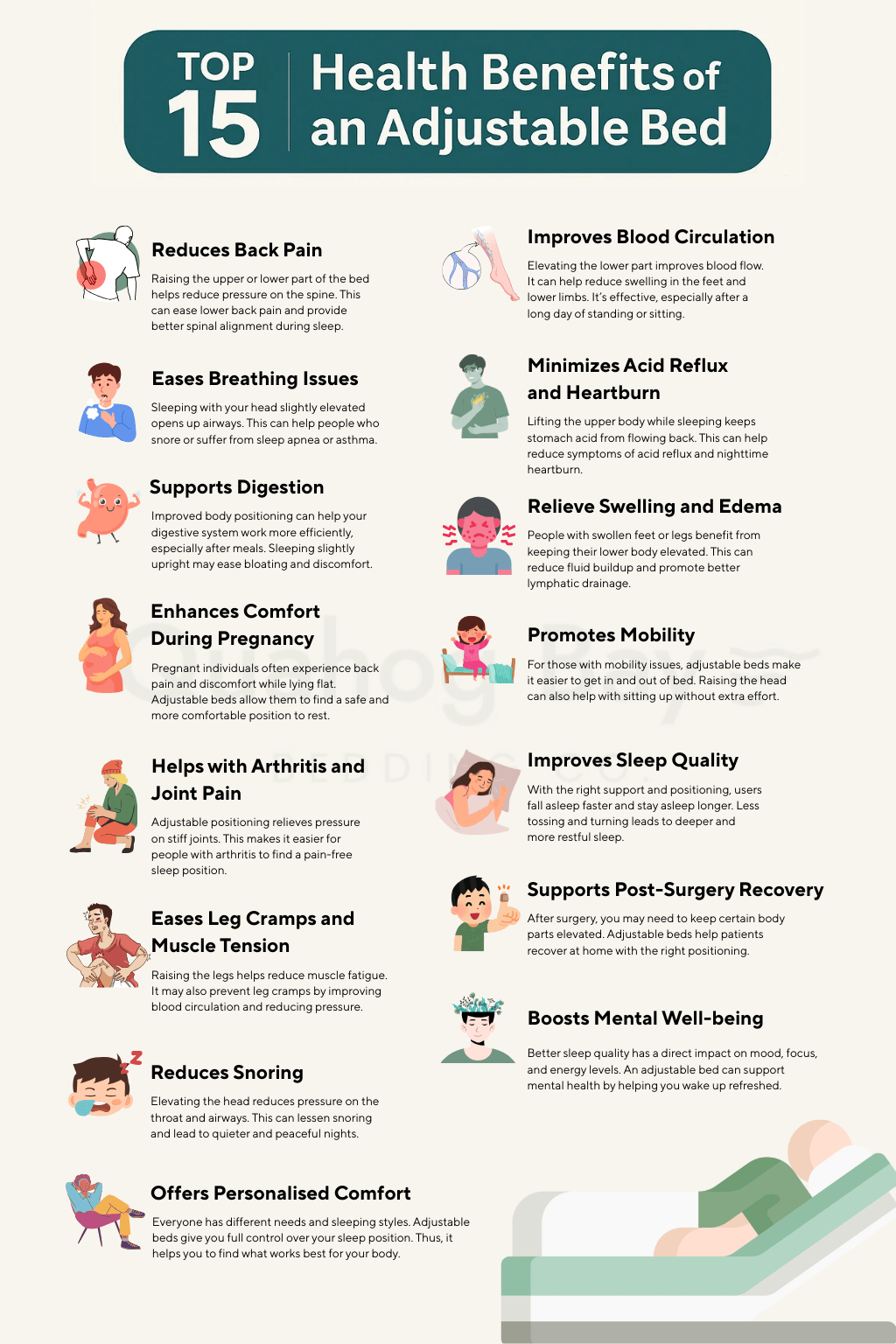
1. Reduces Back Pain
Raising the upper or lower part of the bed helps reduce pressure on the spine. This can ease lower back pain and provide better spinal alignment during sleep.
2. Improves Blood Circulation
Elevating the lower part improves blood flow. It can help reduce swelling in the feet and lower limbs. It’s effective, especially after a long day of standing or sitting.
3. Eases Breathing Issues
Sleeping with your head slightly elevated opens up airways. This can help people who snore or suffer from sleep apnea or asthma.
4. Minimizes Acid Reflux and Heartburn
Lifting the upper body while sleeping keeps stomach acid from flowing back. This can help reduce symptoms of acid reflux and nighttime heartburn.
5. Supports Digestion
Improved body positioning can help your digestive system work more efficiently, especially after meals. Sleeping slightly upright may ease bloating and discomfort.
6. Relieve Swelling and Edema
People with swollen feet or legs benefit from keeping their lower body elevated. This can reduce fluid buildup and promote better lymphatic drainage.
7. Enhances Comfort During Pregnancy
Pregnant individuals often experience back pain and discomfort while lying flat. Adjustable beds allow them to find a safe and more comfortable position to rest.
8. Promotes Mobility
For those with mobility issues, adjustable beds make it easier to get in and out of bed. Raising the head can also help with sitting up without extra effort.
9. Helps with Arthritis and Joint Pain
Adjustable positioning relieves pressure on stiff joints. This makes it easier for people with arthritis to find a pain-free sleep position.
10. Improves Sleep Quality
With the right support and positioning, users fall asleep faster and stay asleep longer. Less tossing and turning leads to deeper and more restful sleep.
11. Eases Leg Cramps and Muscle Tension
Raising the legs helps reduce muscle fatigue. It may also prevent leg cramps by improving blood circulation and reducing pressure.
12. Supports Post-Surgery Recovery
After surgery, you may need to keep certain body parts elevated. Adjustable beds help patients recover at home with the right positioning.
13. Reduces Snoring
Elevating the head reduces pressure on the throat and airways. This can lessen snoring and lead to quieter and peaceful nights.
14. Boosts Mental Well-being
Better sleep quality has a direct impact on mood, focus, and energy levels. An adjustable bed can support mental health by helping you wake up refreshed.
15. Offers Personalized Comfort
Everyone has different needs and sleeping styles. Adjustable beds give you full control over your sleep position. Thus, it helps you to find what works best for your body.
Adjustable Beds vs Regular Beds
When it comes to choosing the right bed, comfort isn’t the only factor to consider. The type of bed you sleep on can affect your posture, pain levels, and ultimately your sleep. Unlike regular beds, adjustable beds provide customizable support to meet your body’s needs. Here’s a quick comparison to help you understand the key differences.
|
Feature |
Adjustable Bed |
Regular Bed |
|
Position Flexibility |
Head and foot positions can be adjusted |
Fixed, flat surface only |
|
Pain Relief |
Helps reduce back pain, joint pain, and pressure |
May not provide the relief |
|
Blood Circulation |
Improves blood flow with leg elevation |
Limited circulation support |
|
Snoring & Breathing Relief |
Elevates the head to reduce snoring and breathing issues |
No support for snoring or breathing relief |
|
Acid Reflux Relief |
Upper body elevation helps reduce acid reflux |
Lying flat can worsen symptoms |
|
Comfort Customization |
Personalized settings for different needs |
One standard sleeping position |
|
Ease of Use for Mobility |
Makes getting in/out of bed easier for seniors or those recovering |
No movement assistance |
|
Cost |
Generally, more expensive due to advanced features |
More affordable |
|
Technology |
Often includes remote controls, massage, and USB ports |
Basic, no tech features |
Do Adjustable Beds Need Special Sheets?

Adjustable beds often require specially designed sheets. Since these beds move and shift, regular sheets can easily slip off, bunch up, or become uncomfortable. At Quahog Bay, we specially design our sheets for adjustable beds. Whether the bed is raised or lowered, they are made to stay in place. Here’s what makes them different:
-
Deep-Pocket Fitted Sheets
These sheets have extra depth to fit snugly over thicker adjustable mattresses. -
Corner Straps or Anchor Bands
Built-in straps help keep the sheet secured to the mattress, even when it shifts position. -
Flexible or Stretch Fabrics
Materials like jersey knit and bamboo stretch naturally and move with the bed without tearing or slipping. -
Split-Sheet Options
For split king or split queen adjustable beds, look for sets designed for individual mattress movement—typically with two fitted sheets, one flat sheet, and pillowcases.
Using the right sheets improves your sleep by eliminating bunching and discomfort. For the best results, consider fitted sheets made specifically for adjustable beds. Look for a cinch or grip system for a secure hold. At Quahog Bay Bedding Co., we offer a range of fitted sheets for all sorts of preferences. Check out our collection for CinchFit adjustable bed sheets, Flannel sheets, and more.
What are the Pros and Cons of Adjustable Beds?
Adjustable beds have grown in popularity for a reason. They offer customized comfort, health benefits, and modern convenience. But like any other gadget, they come with both advantages and disadvantages. Here’s a closer look at the pros and cons to help you decide if an adjustable bed is right for you.
Pros of Adjustable Beds
-
Personalized Comfort
Adjustable beds allow you to raise your head, feet, or both. So you can find the most comfortable position for sleeping, reading, or relaxing. -
Relief from Pain
They help reduce pressure on the spine, joints, and muscles. Adjustable positions can ease back pain, arthritis, and other chronic conditions. -
Better Circulation
Raising the legs promotes blood flow, which is helpful for those with poor circulation, swelling, or varicose veins. -
Reduced Snoring and Improved Breathing
Sleeping with your upper body slightly elevated opens the airways and can reduce snoring, sleep apnea symptoms, and congestion. -
Acid Reflux and Heartburn Relief
An inclined sleeping position helps prevent stomach acid from rising into the esophagus, easing nighttime discomfort. -
Easier Mobility
For seniors or people recovering from surgery, adjustable beds make it easier to get in and out of bed or find a position that doesn’t strain the body. -
Great for Relaxation
Many models come with features like massage, under-bed lighting, or USB ports, enhancing the overall bedroom experience.
Cons of Adjustable Beds
-
Higher Cost
Adjustable beds are more expensive than traditional bed frames, especially when adding premium features or a split base design. -
Heavier and Bulkier
They are typically heavier and more difficult to move or rearrange, which can be inconvenient during a room refresh or relocation. -
Can Be Noisy
The motors used to adjust the bed can produce noise, especially on older or lower-end models. -
Compatibility Limitations
Not all mattresses work with adjustable bases. You may need to purchase a compatible mattress, which adds to the total cost. -
Requires Special Sheets
Standard fitted sheets may not stay in place. You’ll need deep-pocket or adjustable-specific sheets that fit securely as the bed moves. -
Electrical Dependency
Adjustable beds rely on electricity to function. A power outage may prevent the bed from moving to your preferred position.
What to Consider Before Buying an Adjustable Bed?
An adjustable bed can be a valuable upgrade, but it’s also a long-term investment. Before purchasing, it’s important to look at their features, compatibility, and overall lifestyle fit. Here are key factors to consider:
-
Mattress Compatibility
Not all mattresses work with adjustable bases. Memory foam, latex, and hybrid mattresses are usually best. Innerspring mattresses may not be as flexible. Make sure your current mattress is compatible, or you may need to purchase a new one. -
Bed Size and Room Space
Adjustable beds tend to be bulkier than traditional ones. Make sure it's according to your bedroom size. Especially, if you're considering a split king or models with headboard/footboard attachments. -
Features and Controls
Modern adjustable beds come with a wide range of features. They may include massage functions, zero-gravity settings, and wireless remotes. Decide what features are important for your comfort and convenience. -
Noise Level
Some beds can be noisy when adjusting. If you’re a light sleeper or share your bed, opt for a model with quiet motors and smooth transitions. -
Health Needs
If you're buying for health needs, such as back pain, snoring, or recovery from surgery, look for features that specifically address those issues. -
Warranty and Support
Check the warranty details for both the base and the motor components. A longer warranty often reflects better build quality. Also, consider customer service and return policies. -
Budget
Adjustable beds can range from a few hundred to several thousand dollars. Have a clear idea about your budget and look for models that balance price and value. -
Ease of Assembly
Some adjustable beds are simple to set up, while others may require professional installation. If you can’t assemble it yourself, check if the brand offers in-home setup. -
Partner Preferences
For couples, a split adjustable bed allows each person to control their side. This is especially helpful if your sleep needs or positions differ.
Conclusion
An adjustable bed is more than just a modern bedroom upgrade. It supports better sleep, eases pain, and improves your overall health. From reducing back pain to helping with snoring and acid reflux, it provides a number of health benefits. While they cost more and need special sheets, the comfort and health perks often make it worth it. If you value restful sleep and need better support, an adjustable bed might be the perfect choice for your lifestyle.

